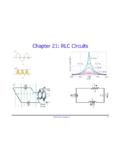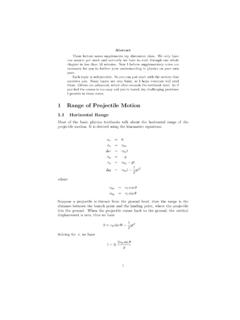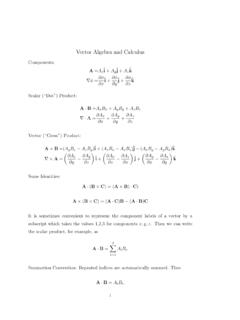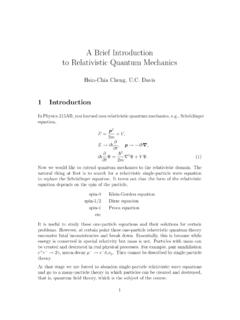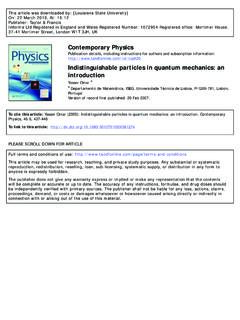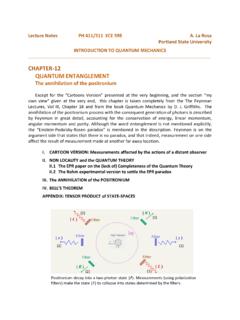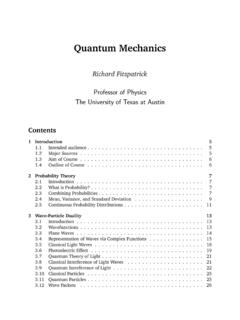Transcription of PHY4604{Introduction to Quantum Mechanics Fall …
1 phy4604 introduction to Quantum MechanicsFall 2004 Final Exam SOLUTIONSD ecember 17, 2004, 7:30 9:30 other materials allowed. If you can t do one part of a problem, solve subsequentparts in terms of unknown answer define clearly. If you don t know a formula ask, Imight be able to help. All parts 10 pts., max=120. Problem 1 required, attempt 2 ofremaining 3 problems; circle which ones you want helpful formulae and constants L+ `m= h `(`+ 1) m(m+ 1) `m+1 L `m= h `(`+ 1) m(m 1) `m 1En= m2 h2[e24 0]2 1n2En= h (n+12) L2= L+ L + L2z h Lz= L L++ L2z+ h LzH =E H =i h tH= h22m 2+V(r) 0dx xne x=n!
2 Dx e x2= dx x2e x2= 2 0(x) =1 1/2x0e 12(xx0)2 1(x) =1 2 1/2x0(2xx0)e 12(xx0)2 2(x) =1 8 1/2x0(4(xx0)2 2)e 12(xx0)21 3(x) =1 48 1/2x0(8(xx0)3 12xx0)e 12(xx0)2R10= 2a 3/20e r/a0R20=1 2a 3/20(1 12ra0)e r/2a0R21=1 24a 3/20ra0e r/2a0L = he i ( +icot )Y00=1 4 Y01= 34 cos Y 11= 38 sin e i x=[0 11 0] y=[0 ii0] z=[1 00 1]~ = eg2mS h= 1 10 34J sme= 9 10 31kgmee42 h2= 1 Rydberg = = 10 19Ja0= h2/(mZe2) Answer. Must attempt (only) 4 of 6. Circle answers to be graded.(a)Identify and discuss: wave packetA wave packet is a wave function describing a propagating particlelocalized in space.
3 In general, we can write (x, t) = dp 2 heipx/ h (p, t)where (p, t) is an envelope function describing a distribution ofmomenta present in the wave function . If is sharply peaked aroundone value ofp, will look like a plane wave and be spread out overa large region of space. On the other hand, if is roughly constantinp, will look like a delta function, and be strongly peaked at aparticularx(for givent). Ehrenfest theoremEhrenfest s theorem says that the motion of expectation values inquantum Mechanics is classical. More specifically,d p dt= i h [H, p] = i h i hdVdx = d V dx,where the right hand side is now just the classical force on a particle, this is Newton s law on the average.
4 Pauli principlePauli s principle for 2 particles states that the wave function mustbe symmetric or antisymmetric under exchange of particle labels, de-pending on whether the particles are integer (bosons) or half-integer(fermion) spin, respectively. Mathematically, if 1 represents all the la-bels, coordinates or Quantum numbers associated with particle 1, and2 is the same for particle 2, we must have (1,2) = (2,1), where+ is for bosons and - for fermions ( electrons).(b)Consider two electrons in a potential well withV= except forV= 0for 0 x a.
5 What is the ground state wavefunction for the 2-particlesystem if the particles have parallel spins? Label your answer in terms ofthe eigenstates in(x) of particlei(i= 1,2), and state what these the infinite square well problem as stated, the eigenfunctions are n(x) = 2/asinn x/a. The ground state for 2 particles with parallelspins will be a spin triplet (S=1), (1,2) = ( 0(x1) 1(x2) 1(x1) 0(x2)) 3since if both particles were in the single-particle ground state 0, such thatthe energy was 2E0, antisymmetry of the overall wavefunction would forcethe spin wave function to be antisymmetric.
6 So the best we can dowith two parallel spins 1/2 is to put one particle in 0and one in 1, thenantisymmetrize. The lowest energy with parallel spins isE0+E1.(c)Given a physical system with HamiltonianHwhich has an orthonormal setof eigenfunctions n(x) at time t=0, show that these same eigenfunctionsat a later timet, n(x, t) are still need to show that ( n(x, t), m(x, t)) = mnfor all timest. But this isjust( n(x, t), m(x, t)) = (eiHt/ h n(x), eiHt/ h m(x))= (eiEnt/ h n(x), eiEmt/ h m(x))=ei(Em En)t/ h( n(x), m(x))=ei(Em En)t/ h mn= mn,where the last step follows because mnis only nonzero whenm=n.
7 (d)Define the uncertainty in the value of an operator Qas Q= Q2 Q 2.(1)Suppose an electron is known to be in an eigenstate of L2and Lz, | =|`m . Show explicitly that L2= 0, Lz=0, but Lx6= 0. L2 = `m|L2|`m = h2`(`+ 1) `m|`m = h2`(`+ 1) Lz = `m|Lz|`m = hm (L2)2 = `m|(L2)2|`m = h2`(`+ 1) `m|L2|`m = h4`2(`+ 1)2 Lx = `m|L++L 2|`m =12 `m|( ..|`m+ 1 + ..|`m 1 )= 0 `m|L2x|`m = `m|(L++L 2)2|`m = `m|L L++L+L 2|`m = h22 `m|(`(`+ 1) m(m+ 1)) + (`(`+ 1) m(m 1))|`m = h2(`(`+ 1) m2),so there must be an uncertainty in a measurement ofLxif the system isprepared in anL2, Lzeigenstate, since [Lx, Lz]6= 0.
8 (e)Compare the wavelengths of the 2p 1stransitions in hydrogen (oneproton, no neutrons) and deuterium (one proton, one neutron). Give youranswer in terms of the ratio between the two transitionwavelengths H:4 D, which depends only onx me/mp(neglect the proton-neutron massdifference, and give only the leading term in powers ofx).The energy which must be carried away by a photon in the transition isE2 E1=hc/ , so H=hc/(E2 E1) =8 h33 (4 0e2) =mmp/(m+mp) is equal tomup to an error of orderO(10 3).For Deuterium we have = 2mmp/(m+ 2mp), so H D=2(m+mp)m+ 2mp 1 +x2(f)What is the degeneracy of the 2nd excited state (E= (7/2) h ) of theisotropic 3D simple harmonic oscillator?
9 The energies of the eigenstates of the 3D SHO are given byE=Ex+Ey+Ez, whereE = h (n + 1/2), =x, y, z, wheren are positive altogetherE= h (nx+ny+nz+ 3/2).To get (7/2) h , we need twoquanta, which can be distributed in any way amongx, y, z. So we havestates labelled|nxnynz with possibilities|200 ,|020 ,|002 ,|110 ,|101 ,|011 , for a degeneracy of electron in aH-atom is in a state described by =1 6[2 100+ 211+ 21 1](2)(a)Calculate the expectation value of Lzin this state. Lz =16(2 100+ 211+ 21 1,2(0 h) 100+ ( h) 211+ ( h) 21 1)= 0(b)What is the probability a measurement of the energy will yield the Rydberg?
10 Wave function has amplitude1 6( 211+ 21 1) to be in then= 2 Bohrorbit with energy Ryd. Probability is therefore 1/6+1/6 = 1 additional electron is now added to theH-atom, forming anH (c)Write down the Schr odinger equation for the system in terms of the elec-tron coordinatesr1andr2, and show that, if you neglect the Coulombinteractionbetweenthe electrons, it separates into two decoupled equa-tions, one for each of the two h22m 21 e24 0r1 h22m 22 e24 0r2+e24 0|r1 r2|.If we neglect the last term, the Hamiltonian separates into a sum of twoindependent Hamiltonians, the 1st of which acts only on the coordinatesof the first particle, the second on those of the second.


